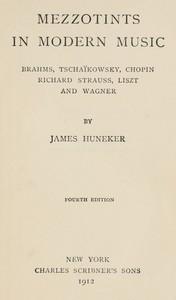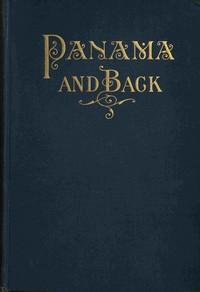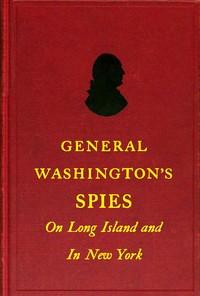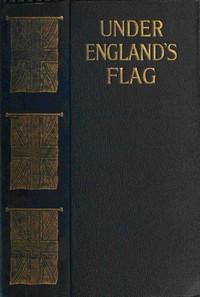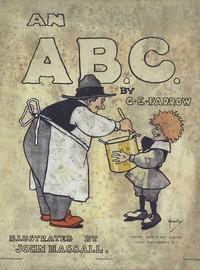|
|
Read this ebook for free! No credit card needed, absolutely nothing to pay.Words: 37482 in 28 pages
This is an ebook sharing website. You can read the uploaded ebooks for free here. No credit cards needed, nothing to pay. If you want to own a digital copy of the ebook, or want to read offline with your favorite ebook-reader, then you can choose to buy and download the ebook.

: Mezzotints in modern music by Huneker James - Liszt Franz 1811-1886; Wagner Richard 1813-1883; Chopin Frédéric 1810-1849; Music 19th century History and criticism; Brahms Johannes 1833-1897; Tchaikovsky Peter Ilich 1840-1893; Strauss Richard 1864-1949@FreeBooksThu 08 Jun, 2023 r Flaubert's great chiselled art, and I would give a wilderness of Rubens for one Whistler. I know this may be a confession of aesthetic narrowness, but I never could bow down to overgrown reputations, nor does the merely big excite my nerves. In this matter I agree unreservedly with Mr. Finck. I would rather read Poe's Silence than all the essays of Macaulay, and can echo George Sand, who wrote that one tiny prelude of Chopin is worth all the trumpeting of Meyerbeer. It was in this spirit I approached Chopin years ago; it is in the same spirit I regard him to-day. But while my vantage ground has not perceptibly shifted, I descry a Chopin other than the melancholy dreamer I knew a decade ago. My glances are imprisoned by new and even more fascinating aspects of this extraordinary man and poet. It is of the greater Chopin I would speak; the Chopin not of yester-year, but the Chopin of to-morrow. The old Chopin is gone for most of us. The barrel organ--not Mallarm?'s organ, but that deadly parallel for pianists, the piano-organ, with its super-Janko technic--now drives the D flat valse across its brassy gamut helter-skelter. The E flat nocturne is drummed by schoolgirls as a study in chord playing for the left hand, and the mazourkas--heaven protect us!--what have not these poor dances, with their sprightly rhythms, now wilted, been subjected to; with what strange oaths have they not been played? Alas! the Chopin romance is vanished. His studies follow those of the prosaic Clementi, and Du Maurier nabbed one of his impromptus for Trilby. Poor Chopin! devoured by those ravening wolves, the concert pianists, tortured by stupid pupils and smeared with the kisses of sentimentalists, well may you cry aloud from the heights of Parnassus, "Great Jove, deliver me from my music!" What is left us in all this furious carnage, what undefiled in this continuous rape, this filching of a man's spiritual goods? Some few works unassailed, thanks to the master--some noble compositions whose sun-smitten summits are at once a consolation and an agony. To strive, to reach those wonderful peaks of music is granted but to the few. Even that bird of prey and pedals, the professional piano reciter, avoids a certain Chopin, not so much from instinctive reverence, but because of self-interest. He understands not, and also knows full well that his audiences do not. This hedges the new Chopin from cheap, vulgar commerce. I have been criticised for asserting that in Chopin's later works may be found the germ of the entire modern harmonic scheme. It was not in the use of the chord of the tenth alone that Chopin was a path-breaker. Even in his first book of studies may be found a melodic and harmonic scheme, without which the whole modern apparatus of composition would not be as it is now. Does this sound daring? Come, put it to the test! That wonderful upward inflection which we look upon as Wagner's may be found in the G sharp minor part of the C minor study in opus 10. Look at it! Sift its significance and then revert to Isolde's Liebestod, or Wotan's entrance in the third act of Die Walk?re. There is the nub of the entire system of modern emotional melody. Take all the ?tudes and what treasures do we not find? The lovely Fantaisie-polonaise, op. 61, has an introduction which is marvellous and which will sound new a century hence. There is a kernel of a figure that will surprise the Wagnerite who knows his Ring. I speak of a triplet figure in sixteenths in the introduction. It was the late Anton Seidl who first called my attention to the "Chopinisms" of the wonderful love-duet in the second act of Tristan. He said Wagner had laughed about the coloring. If Wagner is the oak tree, then Chopin is the acorn of the latter-day music. What is this new Chopin I pretend to see? Or is it only as the soul in Browning's poem, All that I Know of a certain Star? Does my Chopin star dart now red, now blue, for me alone? Chopin left us four ballades and a fantaisie in F minor, which is a tremendous ballade, although not in the traditional ballade form. But it has unmistakably the narrative tone; it tells an overwhelmingly dramatic story. Yet of the four ballades, who dare play the first and second in G minor and A flat? They are hopelessly vulgarized. They have been butchered to make a concert goer's holiday. The G minor, full of dramatic fire and almost sensual expression, is a whirlwind; unsexed by women and womanish men, it is a byword, a reproach. Little wonder that Liszt shuddered when asked to listen to this abused piece. As for the A flat ballade, I can say nothing. Graceful, charming, it appeals even to the lovers of music-hall ditties. It, too, has been worried to death. The one in F has been spared for us. It is a thunderbolt in a bed of violets. Its tempest, scurrying and growling, is for the hand of the master. Let no mean disciple juggle with its vast elemental tones. Disaster dire will surely follow. And when the sky has cleared how divinely azure it is! The lilt of the breezes with thin thunder in the distance closes a page that is immortal. When young I had no god but Beethoven, and all other gods were strange. To-day, hemmed in by the noise and dust of the daily traffic of life, I have a tiny sanctuary which I visit betimes. In it is the fourth ballade of Chopin, the one in the mode of F minor. It is a masterpiece in piano literature as the Mona Lisa and Madame Bovary are masterpieces in painting and prose. Its melody, which probes the very coverts of the soul, is haunting in its chromatic coloring, and then that fruitful pause in half notes, the prelude to the end! How it fires the imagination; how unlike the namby-pamby Chopin of the school-room and the critics! The ?tudes are beyond the limit of this paper. I can only say that they are enormously misunderstood and misread. Studies in moods, as well as in mechanism, they are harnessed with the dull, unimaginative creatures of the conservatory curriculum, and so in the concert room we miss the flavor, the heroic freedom of the form. Who plays the C minor in the opus 25? Who ever gives us with true bravoura that dazzling drive of notes, the A minor, the second of the tonality in the same book? De Pachmann plays the study in thirds, but it is only a study, not a poem. When will these series of palpitating music pictures be played with all their range of emotional dynamics? The impromptus are almost denied us. The fantaisie impromptu and the A flat, are they not commonplaces, seldom played beautifully? A greater Chopin is in the one in F sharp, the second. There is the true impromptu spirit, the wandering, vagrant mood, the restless outpouring of fancy. It is delicious. The G flat is practically undiscovered. Of the mazourkas, the impish, morbid, gay, sour, sweet little dances, I need not speak. They are a sealed book for most pianists; and if you have not the savor of the Slav in you you should not touch them. Yet Chopin has done some great things in this form. Think of the three or four in C sharp minor, the one in B flat minor, the curiously insistent one in B minor and that sad, funereal mazourka in A minor, the last composition Chopin put on paper. The singular idea of the last named, almost a fixed one, its hectic gayety and astounding gloom show us the sick brain of the dying man. But it is not upon these works I would dwell. The new, the larger Chopin will be known to posterity by the three great polonaises in F sharp minor, in A flat and the fantaisie polonaise. What a wealth of fantasy there is in opus 61! Its restless tonality, the marked beauty of the first theme, the almost vaporous treatment, the violent mood changes and the richness of the harmonies place this work among the elect. The F sharp minor polonaise and the two in E flat minor and C minor contain some strong, virile writing. They need men, not pianists, to play them. Professor Frederick Niecks calls the F sharp minor polonaise "pathologic," and Stanislaw Przybyszewski, that curious, half-mad genius who, like Verlaine, has seen the inside of prisons, has written surprisingly of the polonaise; indeed, he is said to play it well, and has coupled the composer's name with Nietzsche's in his strange brochure, The Psychology of the Individual. To me the piece far surpasses in grandeur all of Chopin's polonaises, even the "Heroic," with its thunderous cannon and rattling of horses' hoofs. It may be morbid, but it is also magnificent. The triplets in eighth notes in the introduction gradually work up to a climax of great power before the theme enters in single notes. Soon these are discarded for octaves and chords and do not occur again. The second subject in D flat is less drastic, less fantastic, and also less powerful. There is epical breadth in that beginning, and at each reiteration it grows bigger, more awful, until it overflows the limits of the keyboard. That strange intermezzo in A, which comes before the mazourka, is an enigma for most of us. It seems at first irrelevant, but its orchestral intent is manifest, and it leads to the D flat theme now transposed to C sharp minor and full of the blackest despair. If you play the thirty-second notes in octaves more color is obtained. The mazourka which follows tempted Liszt to extravagant panegyric. Its brace of notes, thirds and sixths, are lovely in accent and hue, but do not become languishing in your tempo, or the episode turns sugary and sentimental. With an almost ferocious burst the polonaise is reached, and again begins that elemental chant, which grows huger in rancorous woe until the bottom of the pit is reached, and then without a gleam of light the work ends in a coda, with mutterings like curses of the polonaise theme, and only in the very last bar comes the relief of a crackling and brilliant F sharp in octaves. Pathologic in a sense it is, for it makes its primary appeal to the nerves, but it is wonderful music, though depressing. It hurts the very pulp of one's sensibilities, yet it is never sensational. I am reminded of Salvator Rosa's rugged, sullen and barbarous landscapes with a modern figure in the foreground, agitated, distracted, suicidal; in a word, something that paint and canvas can never suggest. The nocturnes are sometimes beneath contempt. When I hear a Chopin nocturne played on the fiddle or 'cello I murmur complainingly as I listen, for it irresistibly reminds me of degraded beauty. There are exceptions. The vandals have vouchsafed us the one in C sharp minor, the gloomiest and grandest of Chopin's moody canvases. Its middle section is Beethovian in breadth. Ah! my friend, why do you take this piano composer for a weakling? Why give him over to the tough mercies of the Young Person? I would sentence to a vat of boiling oil, that is if I were the Sultan of Life, any woman who presumed to touch a note of Chopin. They have decked the most virile spirit of the age in petticoats, and upon his head they have placed a Parisian bonnet. They murdered him while he was alive, and they have hacked and cut at him since his death. If women must play the piano let them stick to Bach and Beethoven. They cannot hurt those gentlemen with their seductions and blandishments, their amblings and jiggings. There are several other nocturnes that will never appeal to hoi polloi. The noble one in C minor, the fruity one in B and the one in E, form a triad of matchless music. They are not popular. The wonder-child that came to us through the pink gates of the dawn and was rocked to rhythmic dreams in the ber?euse has grown to be a brat of horrid mien and muscular proportions. I will have none of it. Its banal visage is cherished in conservatories. Long may it howl, but not for me! The scherzi, the preludes, you cry! Ah! at last we are getting upon solid ground. The twenty-five preludes alone would make good Chopin's claim to immortality. Such range, such vision, such humanity! All shades of feeling are divined, all depths and altitudes of passion explored. If all Chopin, all music, were to be destroyed, I should plead for the preludes. The cameo stillness of some of them is as soft-spoken sentences in a cloister. Religious truly, but these appeal less to me than those thunder-riven visions in D minor, in B flat minor, in F minor, in E flat minor. Surpassingly sweet is the elegiac prelude in B flat. It is greater than any of the Chopin nocturnes. Number two, with its almost brutal quality and enigmatic beginning, is for a rainy day--a day when the soul is racked by doubts and defeats. It is shuddersome and sinister. About it hovers the grisly something which we all fear in the dark but dare not define. A ray of sunshine, but a sun that slants in the west, is the prelude in G. Why detail these marvels in miniature, these great and cunningly wrought thoughts? Free books android app tbrJar TBR JAR Read Free books online gutenberg More posts by @FreeBooks
: To Panama and back by Byford Henry T Henry Turman - Panama Description and travel; Pan-American Medical Congress (4th : 1905 : Panama Panama)@FreeBooksThu 08 Jun, 2023

: General Washington's spies on Long Island and in New York by Pennypacker Morton - New York (N.Y.) History Revolution 1775-1783; Washington George 1732-1799 Career in espionage; Spies New York (State) History 18th century; Espionage New York (State) History@FreeBooksThu 08 Jun, 2023
|
Terms of Use Stock Market News! © gutenberg.org.in2025 All Rights reserved.

